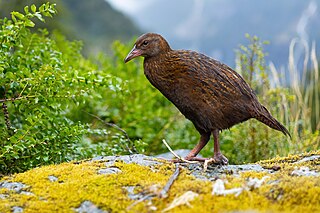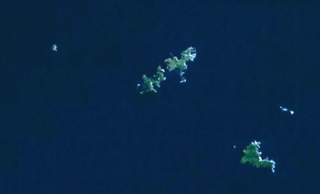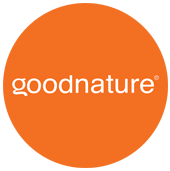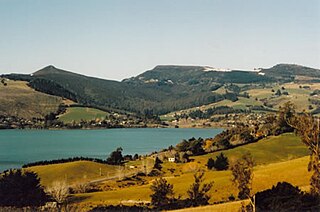
The Department of Conservation is the public service department of New Zealand charged with the conservation of New Zealand's natural and historical heritage.

The weka, also known as the Māori hen or woodhen is a flightless bird species of the rail family. It is endemic to New Zealand. Some authorities consider it as the only extant member of the genus Gallirallus. Four subspecies are recognized but only two (northern/southern) are supported by genetic evidence.

The Buller River is a river in the South Island of New Zealand. The Buller has the highest flow of any river in the country during floods, though it is only the 13th longest river; it runs for 177 km (110 mi) from Lake Rotoiti through the Buller Gorge and into the Tasman Sea near the town of Westport. A saddle at 710 m (2,330 ft) separates the Buller from the Motupiko River and that is divided from the Wairau River by a 695 m (2,280 ft) saddle, both aligned along the Alpine Fault, as is the top of the Buller valley.

Nelson Lakes National Park is in the South Island of New Zealand, at the northern end of the Southern Alps. It was created in 1956. The park contains beech forests, multiple lakes, snow-covered mountains and valleys created by glaciers during the ice ages.

The New Zealand kākā is a large species of parrot of the family Nestoridae found in New Zealand's native forests. The species is often known by the abbreviated name kākā, although it shares this name with the recently extinct Norfolk kākā and Chatham kākā. Two subspecies of New Zealand kākā are recognised. It is endangered and has disappeared from much of its former range, though the re-introduction of North Island kākā at Zealandia in Wellington has led to an increasing population of the birds across the city.
This is a timeline of environmental history of New Zealand. It includes notable events affecting the natural environment of New Zealand as a result of human activity.

Protected areas of New Zealand are areas that are in some way protected to preserve their environmental, scientific, scenic, historical, cultural or recreational value. There are about 10,000 protected areas, covering about a third of the country. The method and aims of protection vary according to the importance of the resource and whether it is publicly or privately owned.
Chalky Island or Te Kākahu-o-Tamatea is an island in the southwest of New Zealand, and is part of Fiordland National Park. It lies at the entrance to Taiari / Chalky Inlet, next to Rakituma / Preservation Inlet, at the southwestern tip of the South Island, 10 kilometres (6 mi) northwest of Puysegur Point, 15 kilometres (9 mi) southeast of West Cape, and 140 kilometres (87 mi) west of Invercargill. Chalky Island is one of the predator-free islands that is part of the Fiordland Islands restoration programme. The programme's focus is to eradicate pests and translocate native species.

Anchor Island is an island in Dusky Sound in Fiordland.

The Mokohinau Islands (Pokohinau), sometimes spelt Mokohīnau Islands are a small group of islands that lie off the northeast coast of New Zealand's North Island. The islands are 100 km (62 mi) northeast of Auckland, 21 km (13 mi) northwest of Great Barrier Island and approximately 52 km (32 mi) east of Bream Head. The main islands of the group include Fanal Island (Motukino), Burgess Island (Pokohinu), Flax Island (Hokoromea), and Atihau Island. Smaller islands include Bird Rock. Most of them are managed by the Department of Conservation as nature reserves and wildlife sanctuaries. Landing is not allowed without a permit, with the exception of Burgess Island, much of which is managed as a scenic reserve by the Department of Conservation. The remainder of Burgess Island is Crown Land and is administered by the Ministry of Transport. The total land area of the Mokohinau Islands is 160 ha (400 acres).

The North Island kōkako is an endangered forest bird which is endemic to the North Island of New Zealand. It is grey in colour, with a small black mask. It has blue wattles. Because of its wattle, the bird is sometimes locally called the blue-wattled crow, although it is not a corvid.

Goodnature is a New Zealand company founded in 2005 by Robbie van Dam and Craig Bond. Goodnature specialises in the production of traps designed for the control of animal pests such as stoats, rats, mice and possums.

Mainland islands are areas on the North Island and South Island of New Zealand, set aside as reserves for endemic and native species, in a similar way to island reserves. Some mainland islands are managed by the Department of Conservation, while others are run by private trusts in collaboration with universities and local communities.
Boundary Stream Mainland Island is a mainland island in the Hawke's Bay Region of New Zealand.
Paengaroa Mainland Island or Paengaroa Scenic Reserve is a mainland island in the Manawatū-Whanganui Region of New Zealand.
Whakarewarewa Conservation Park or Whakarewarewa Forest Park is a mainland island in the Bay of Plenty Region of New Zealand. It lies close to SH 30 to the southwest of Rotorua.
Te Papanui Conservation Park is a mainland island in the Otago Region of New Zealand.

Tauparikākā Marine Reserve is a marine reserve located offshore about 20 kilometres (12 mi) north of Haast on the West Coast of New Zealand's South Island. It covers the area immediately offshore from Ship Creek, which is also known as Tauparikākā in Māori.
Maniniaro / Angelus Peak is a mountain in Nelson Lakes National Park, near the northwestern extent of New Zealand's main divide. Although it is not the tallest peak in the Angelus Ridge or the wider Travers Range, Maniniaro remains a popular tramping destination and is significant to the Ngāti Apa ki te Rā Tō iwi, who claim mana whenua within the area. According to Ngāti Apa ki te Rā Tō beliefs, the mountain is intrinsically linked with nearby Rotomaninitua / Lake Angelus, with the two both said to represent the footprints of the iwi's ancestors as they embarked on their journey back to Hawaiki. It is also near both major lakes of the national park, being roughly 6 kilometres (3.7 mi) from the southern ends of both Lakes Rotoiti and Rotoroa.
The Fiordland Islands restoration programme is run by the New Zealand Department of Conservation. The purpose of the programme is to eradicate pests on key islands around Fiordland National Park, once the islands are considered predator free endangered native species will be translocated to the islands.












